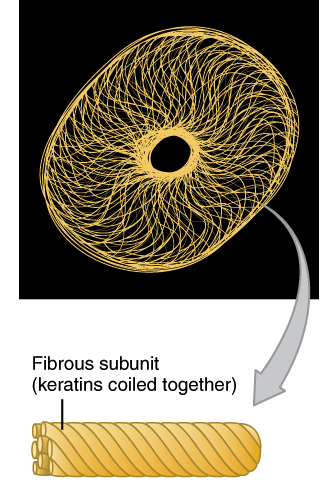Cytoskeleton Function. The cytoskeleton extends throughout the cell’s cytoplasm and directs a number of important functions. It helps the cell maintain its shape and gives support to the cell. A variety of cellular organelles are held in place by the cytoskeleton. It assists in the formation of vacuoles.
Mitosis – Wikipedia
The Cytoskeleton. The cytoskeleton is a cellular “scaffolding” or “skeleton” that crisscrosses the cytoplasm. All eukaryotic cells have a cytoskeleton, and recent research has shown that prokaryotic cells also have a cytoskeleton. The eukaryotic cytoskeleton is made up of a network of long, thin protein fibers and has many functions.

Source Image: pinterest.com
Download Image
The cytoskeleton supports the cell, gives it shape, organizes and tethers the organelles, and has roles in molecule transport, cell division and cell signaling. The microfilaments of this cell are shown in red, while microtubules are shown in green. The blue dots are nuclei.

Source Image: slideplayer.com
Download Image
The cell: Types, functions, and organelles
These elements of the cytoskeleton get their name from the fact that their diameter, 8 to 10 nm, is between those of microfilaments and microtubules. Figure 4.6.3 4.6. 3: Intermediate filaments consist of several intertwined strands of fibrous proteins. Intermediate filaments have no role in cell movement.

Source Image: jacionline.org
Download Image
Which Of The Following Is A Function Of The Cytoskeleton
These elements of the cytoskeleton get their name from the fact that their diameter, 8 to 10 nm, is between those of microfilaments and microtubules. Figure 4.6.3 4.6. 3: Intermediate filaments consist of several intertwined strands of fibrous proteins. Intermediate filaments have no role in cell movement.
The cytoskeleton is the network of fibres forming the eukaryotic cells, prokaryotic cells and archaeans. These fibres in the eukaryotic cells contain a complex mesh of protein filaments and motor proteins that help in cell movement.
Actin dynamics regulation by TTC7A/PI4KIIIα limits DNA damage and cell death under confinement
Microfilaments Of the three types of protein fibers in the cytoskeleton, microfilaments are the narrowest. They function in cellular movement, have a diameter of about 7 nm, and are comprised of two globular protein intertwined strands, which we call actin ( Figure 4.23 ). For this reason, we also call microfilaments actin filaments.
The cytoskeleton (article) | Khan Academy

Source Image: khanacademy.org
Download Image
Biology 2e, The Cell, Cell Structure, Eukaryotic Cells | OpenEd CUNY
Microfilaments Of the three types of protein fibers in the cytoskeleton, microfilaments are the narrowest. They function in cellular movement, have a diameter of about 7 nm, and are comprised of two globular protein intertwined strands, which we call actin ( Figure 4.23 ). For this reason, we also call microfilaments actin filaments.

Source Image: opened.cuny.edu
Download Image
Mitosis – Wikipedia
Cytoskeleton Function. The cytoskeleton extends throughout the cell’s cytoplasm and directs a number of important functions. It helps the cell maintain its shape and gives support to the cell. A variety of cellular organelles are held in place by the cytoskeleton. It assists in the formation of vacuoles.
Source Image: en.wikipedia.org
Download Image
The cell: Types, functions, and organelles
The cytoskeleton supports the cell, gives it shape, organizes and tethers the organelles, and has roles in molecule transport, cell division and cell signaling. The microfilaments of this cell are shown in red, while microtubules are shown in green. The blue dots are nuclei.

Source Image: medicalnewstoday.com
Download Image
Cytoskeleton | Definition, Function & Components – Video & Lesson Transcript | Study.com
The cytoskeleton is a network of different protein fibers that provides many functions: it maintains or changes the shape of the cell; it secures some organelles in specific positions; it enables movement of cytoplasm and vesicles within the cell; and it enables the cell to move in response to stimuli. There are three types of fibers within the

Source Image: study.com
Download Image
4. Eukaryotic Cells – LabXchange
These elements of the cytoskeleton get their name from the fact that their diameter, 8 to 10 nm, is between those of microfilaments and microtubules. Figure 4.6.3 4.6. 3: Intermediate filaments consist of several intertwined strands of fibrous proteins. Intermediate filaments have no role in cell movement.

Source Image: labxchange.org
Download Image
Cell & Cytoskeleton – Quiz, Trivia & Questions
The cytoskeleton is the network of fibres forming the eukaryotic cells, prokaryotic cells and archaeans. These fibres in the eukaryotic cells contain a complex mesh of protein filaments and motor proteins that help in cell movement.

Source Image: proprofs.com
Download Image
Biology 2e, The Cell, Cell Structure, Eukaryotic Cells | OpenEd CUNY
Cell & Cytoskeleton – Quiz, Trivia & Questions
The Cytoskeleton. The cytoskeleton is a cellular “scaffolding” or “skeleton” that crisscrosses the cytoplasm. All eukaryotic cells have a cytoskeleton, and recent research has shown that prokaryotic cells also have a cytoskeleton. The eukaryotic cytoskeleton is made up of a network of long, thin protein fibers and has many functions.
The cell: Types, functions, and organelles 4. Eukaryotic Cells – LabXchange
The cytoskeleton is a network of different protein fibers that provides many functions: it maintains or changes the shape of the cell; it secures some organelles in specific positions; it enables movement of cytoplasm and vesicles within the cell; and it enables the cell to move in response to stimuli. There are three types of fibers within the